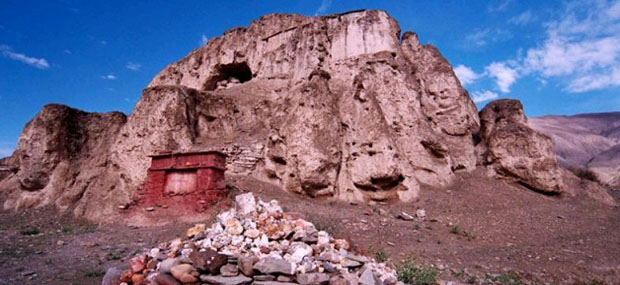Introduction
Perhaps the highlight of this tour is a journey to the Guge Kingdom.It is probably the most interesting area in all of Tibet and the highest ancient kingdom in the world.
Legend has it that in the first half of 20th century the Tibetan government sent a soldier to Guge to collect taxes. However, a couple of days later the soldier returned in a very frightened state, he told the govenor that all he could see there was a world of sand. On hearing this the government dropped the taxation plan.
Guge is barren, desolate and inaccessible for all but the very hardy. The kingdom became an extremely powerful one and it survived for over 700 years from the 9th to 17th century. Altogether 16 kings ruled Guge and yet historical records reveal little about its rise and sudden demise. It was only from letters by western missionaries that people got to know more about the lost empire.
Records show that Guge once made great religious and economic achievements. However its glory was reduced to pieces when the mighty kingdom was involved in a fatal war in the 17th century. The invasion of the neighboring state Ladakh coupled with a domestic rebellion of Guge monks, brought the kingdom to its knees.
The ruins are the only visible legacy Guge has left behind, they extend from the mid-ridge of a hill 300 meters high at its peak and cover an area of 720,000 square meters. Archaeologists have unearthed 445 earthen and wooden structures, 879 caves, 58 blockhouses (a kind of fortification building), four secret tunnels, 28 stupas (traditional pagoda-shaped Buddhist monuments) along with granaries and weaponry storehouses.
An added bonus of this tour is a trip to Mt. Kailash. This holy mountain is popular among both Buddhists and Hindus and worshiped by both.
Mt. Kailash, 6,740 m. is situated to the north of the Himalayan barrier, wholly within Tibet. It is the perfect mountain in so many and stands serene with all its awesome beauty 4 great faces look out to this world and the one beyond. It is the spiritual centre for four great religions: Tibetan Buddhism, Hinduism, the Jain religion and the pre-Buddhist animistic religion – Bonpo.
To Tibetans it is known as Khang Rimpoche (Precious Jewel of Snow) and they see it as the navel of the world. It is said that a stream from the mountain pours into a nearby lake and from here rivers flow in the four cardinal directions. The River of the Lion Mouth to the North, the River of the Horse Mouth to the east, the River of the Peacock Mouth to the south and the River of the Elephant Mouth to the West. Strangely enough, four major rivers do indeed originate near Kailash, the Indus, the Yarlung Tsangpo (Brahmaputra), the Karnali and the Sutlej. Tibetans believe that it is the residence of Demchog, a fierce looking tantric deity who lives there with his consort, Dorje Phagmo. For the Tibetans also it is a particularly special place where poet saint Milarepa, spent several years here meditating in a cave.
For the Hindus Mount Kailash is the earthly manifestation of Mt. Meru, their spritual centre of the universe, described as a fanatastic ‘world pillar’ 84,000 miles high and around which all else revolves.Its roots are firmly rooted in the lowest hell and its summit rises so high to kiss the heavens. On the top their most revered God, Shiva, and his consort Parvati live.
For the Jains, an Indian religious group, Kailash is the site where their first prophet achieved enlightenment. For the older, more ancient religion of Bon, it is the site where its founder Shanrab is said to have descended from heaven. It was formerly the spiritual centre of Zhang Zung, the ancient Bon Empire that once included all of western Tibet. Bon people walk around the mountain in a counter clockwise manner, unlike the other religions.
Over the centuries pilgrims have constantly travelled immense distances to achieve enlightement or cleanse themselves of sin, braving enourmous distances, particularly harsh weather and bandit attacks.
Itinerary
Day 01: Kathmandu to Nyalam
Day 02: Nyalam to Lhatse
Day 03: Lhatse to Xigatse
Day 04: Xigatse to Gyantse
Day 05: Gyantse to Lhasa ,
Day 06: Visit: Sera Monastery, Drepung Monastery, Norbulingke Park.
Day 07: Visit: Potala Palace, Jokhang Temple, Barkhore Street.
Day 08: Lhasa / Gyantse / Shigatse.
Day 09: Shigatse / Sakya / Lhatse
Day 10: Lhatse to Saga
Day 11: Saga to Paryang
Day 12: Paryang to Lake Manasarovar
Day 13: Lake Manasarovar / Darchen
Day 14: Darchen to Drirapuk, Overnight guesthouse & Camp
Day 15: Dera Phuk Gomba to Zutul Phuk Overnight guesthouse & Camp
Day 16: Finish trek and drive to Tirtha Puri
Day 17: TirthaPuri to Guge Kingdom
Day 18: Guge Kingdom to Tirthapuri
Day 19: Tirthapuri to Gosul Gomba
Day 20: Gosul Gomba to Saga
Day 21: Zongba to Nyalam and cross boarder and drive to Kathmandu

